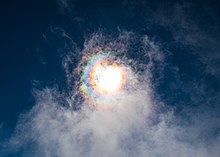Corona (optical phenomenon)


In meteorology, a corona (plural coronae) is an optical phenomenon produced by the diffraction of sunlight or moonlight (or, occasionally, bright starlight or planetlight)[1] by individual small water droplets and sometimes tiny ice crystals of a cloud or on a foggy glass surface. In its full form, a corona consists of several concentric, pastel-colored rings around the celestial object and a central bright area called an aureole.[2][3] The aureole is often (especially in case of the Moon) the only visible part of the corona and has the appearance of a bluish-white disk which fades to reddish-brown towards the edge. The angular diameter of a corona depends on the sizes of the water droplets involved; smaller droplets produce larger coronae. For the same reason, the corona is the most pronounced when the size of the droplets is most uniform. Coronae differ from halos in that the latter are formed by refraction (rather than diffraction) from comparatively large rather than small ice crystals.
The diffraction pattern of the corona resembles an Airy disk, although the underlying physical mechanisms are quite different.
Pollen coronae
[edit]Pollen suspended in the air can also cause diffraction of sunlight that produces coronae. Because pollen grains are not always spherical, the resulting pollen coronae often have characteristic elliptic shape and brighter spots in them. They can be seen during blooming season where there is significant source of pollen like forests. They are more easily seen during sunset or sunrise as there is less sun glare and the light path through pollen laden atmosphere is longer.[4]
See also
[edit]References
[edit]- ^ Cowley, Les (2012). "Jupiter corona from Iran". Atmospheric Optics. Retrieved 2016-05-02.
- ^ Calvert, J. B. (2 August 2003). "The Corona". University of Denver. Retrieved 2017-02-11.
- ^ Cowley, Les. "Corona". Atmospheric Optics. Retrieved 2017-02-11.
- ^ King, Bob (31 May 2015). "Allergies? Must Be Pollen Corona Season Again". Universe Today. Retrieved 17 November 2021.
External links
[edit]- Explanation and image gallery - Atmospheric Optics by Les Cowley
- Rings around the sun and moon: coronae and diffraction
- Corona from Fogged Eyeglasses
- Experimental simulations of pollen coronas
- The Corona
Gallery
[edit]- Forest Corona
- Solar Corona at Golden Gate Bridge
- Partial Corona at Golden Gate Bridge
- Lunar aureole
- Lunar corona with Altocumulus floccus
- Lunar aureole as seen from Mumbai
- A solar corona soon after sunrise


 French
French Deutsch
Deutsch





